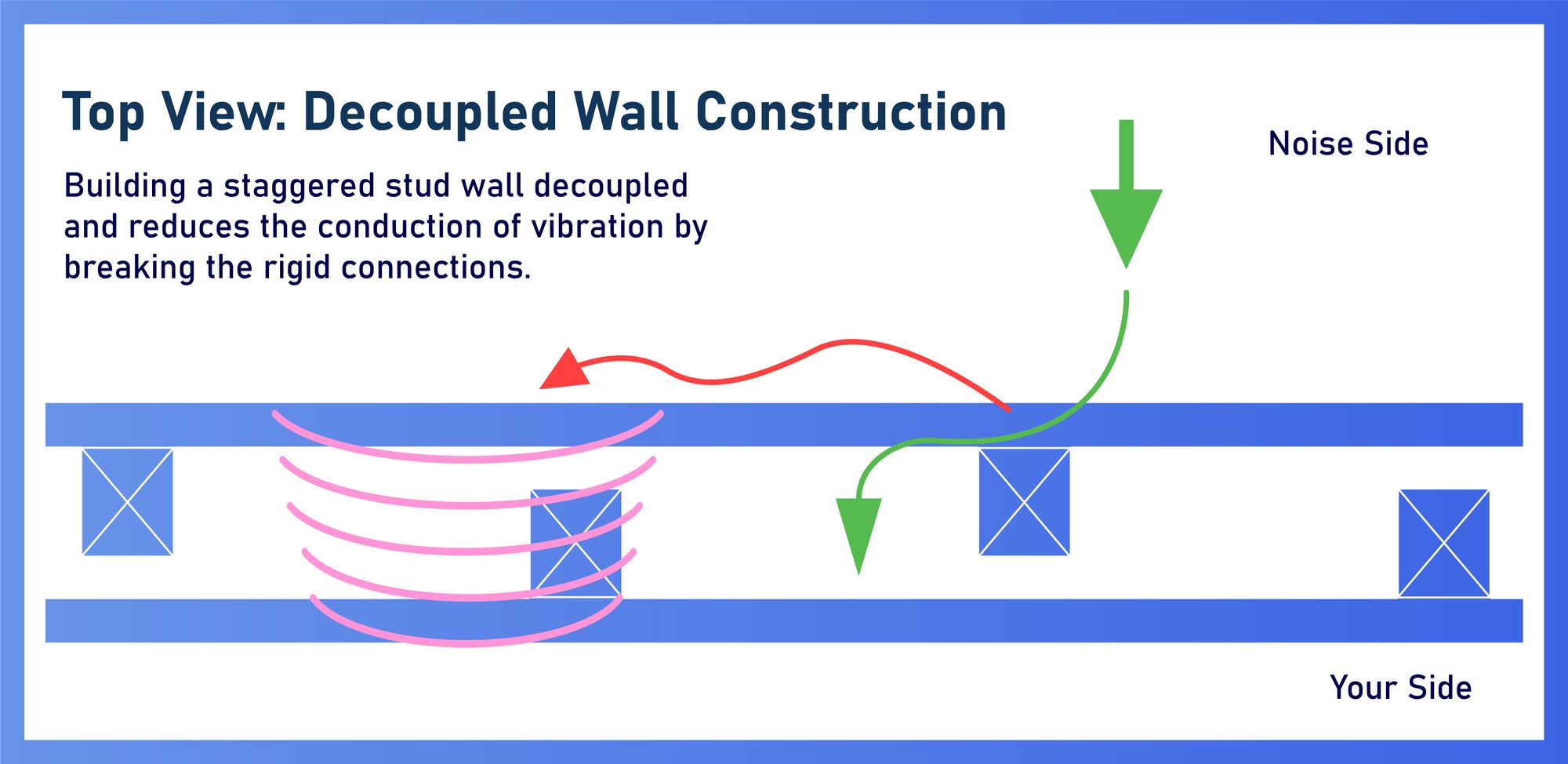- What Is Sound Proofing?
- How to Sound Proof a Room
2.1 Door Weather Stripping
2.2 Wall Hangings
2.3 Rugs
2.4 Absorb Vibrations
2.5 Window Treatments
2.6 Build Bookcases
2.7 Add Extra Drywall
2.8 Install Resilient Channels - The Main Methods
3.1 Adding Mass
3.2 Damping
3.3 Decoupling
3.4 Filling Air Gaps - How To Sound Proof Your Room
4.1 How to Sound Proof a Room for Cheap
4.2 How to Sound Proof Windows - How Much Does It Cost to Sound Proof a Room?
- Pros and Cons of Soundproofing
- Improve Soundproofing with Decibel Pro App
With the world outside getting noisier and noisier, blocking out incoming noise and enjoying a bit of silence is something many of us long for.
While you cannot really do that outside, apart from wearing noise-canceling headphones, you can cut out the noise inside your home. Especially if your neighbor can’t keep the volume down on his favorite music!
If you’re looking for the best way to soundproof a room, keep reading. We’ve lined up everything there is to know about how to soundproof a room and what the best ways to do it are.
What Is Sound Proofing?
Soundproofing is any method used for blocking or reducing unwanted noise. It is commonly used in homes and offices to block sound from coming in but also in places like clubs or music studios, where the intention is to keep sound from coming in as well as going out.
How to soundproof a room depends on:
- how much noise you are trying to block out or keep in
- what type of noise it is
- what the surface you are trying to soundproof is.
Once you’ve mapped that out, there are several professional soundproofing and DIY methods you can apply to soundproof your room or any other space.
How to Sound Proof a Room
To start off, here are some of the most common sound-absorbing and sound-blocking solutions on how to soundproof a room:
Door Weather Stripping
Noise can get in through any cracks and gaps. It can basically get in anywhere air can. Weatherstripping has very good insulation properties as it is made of foam rubber. Plus, it’s also cheap.
While we usually only think of weather stripping exterior doors and windows, interior doors can also benefit from this solution when you are trying to sound proof a room. Using some peel-and-stick weather stripping on your interior doorways and sealing any gaps will help create a tight seal and muffle any incoming sounds.
Wall Hangings
Depending on the surfaces of the room you are trying to sound proof, they may reflect, amplify, or absorb sounds.
Most rooms have interior walls made of drywall and outside-facing walls made of concrete or brick. These hard surfaces most likely amplify sound.
One of the easiest ways to sound proof a room is to soften the wall surfaces by hanging tapestries, blankets, or other wall hangings that can absorb sound and make the room quieter.
For a more professional, heavy-duty sound dampening solution, you can try installing sound-absorbing panels on the walls. Depending on your needs, you can choose permanent or retractable panels.
Rugs
Rugs are well-known for their sound-absorbing properties. If you’re looking into how to soundproof a room, don’t forget to add rugs. If not to the walls, at least to the floor. Especially if you have laminate floors.
The thicker the rugs are, the more likely they will be to absorb sound coming from below, as well as block out any noise you are making.
Absorb Vibrations
If you’ve ever noticed how your speakers vibrate when you play loud music, you already know that sound produces vibrations. What you may not know is that this is the way sound can travel through surfaces like walls, ceilings, or floors.
To prevent noise coming from any equipment producing heavy vibrations, put a dense foam rubber mat under it to dampen vibrations and stop sound from traveling further.
Window Treatments
Heavy drapes and curtains are other traditional solutions for how to soundproof a room. They do a good job in particular as they are made from thick materials that can absorb more noise.
As for curtains, regular ones may not block out too much noise. But, if you’re looking for a more professional solution and you have a bigger budget, you can choose noise-reducing curtains that are specially designed for this purpose and made from special soundproofing materials.
Build Bookcases
Books can do a great job of soundproofing a room as they both absorb and block out sound by creating mass.
When soundproofing a room, consider building a large floor-to-ceiling bookcase on an outside-facing wall or a wall that you are sharing with a noisy neighbor.
Add Extra Drywall
If you found any of the other soundproofing methods too light, here’s a heavy-duty one.
Adding an extra sheet of drywall can significantly reduce the amount of noise coming in through a wall. In addition, you also have the option of using sound-deadening caulk as an added soundproofing solution or even installing sound-deadening drywall that comes with a special polymer layer to make the room even quieter.
Install Resilient Channels
This method does require more effort and work, but it can do wonders as it is one of the most efficient ways to sound proof a room.
Resilient channels are Z-shaped metal strips that you can install between the wall studs and the drywall. They mechanically separate the two structures and stop the sound vibrations from passing through.
The Main Methods
If you’re wondering how these soundproofing solutions we’ve provided manage to absorb, block out, or stop sound, here’s the science behind the main methods:
Adding Mass
Dense materials can add mass to a surface like a wall, ceiling, or floor, and stop sound waves from going through.
These dense materials can have one or several layers and can include:
- rubber
- dense foam
- polymer layer drywall
- soundproof sheetrock
- soundproof plywood
Damping
Damping can soundproof a room by limiting the vibrations produced by sound waves or deflecting them. Consequently, materials with sound-dampening properties can reduce acoustic resonance, reflect it or absorb it.
Decoupling
Decoupling is a great solution for soundproofing a room as it can completely separate two structures and prevent sound from traveling through.

The best wall decoupling methods you can use are:
- a double stud wall
- a staggered stud wall
- soundproofing clips
- a resilient channel
Filling Air Gaps
An ai gap is any crack in the insulation that sound can travel through. They can be cracks in the wall, in the door, gaps around electrical outlets, or pipes.
To sound proof a room, you will have to carefully check the walls, ceilings, and floor and cover any air gaps you can find using a sealant.
How To Sound Proof Your Room
Here are a few solutions for how to sound proof your room:
How to Sound Proof a Room for Cheap
Anytime you need to sound proof a room quickly and don’t have the time (or the money) to install professional solutions, you can use things you have around the house already.
The cheapest way is to use blankets or cardboard. We all have blankets around, so finding a few shouldn’t be a problem. The same goes for cardboard boxes.
Next, use the blankets or cardboard to cover the wall where the noise is coming from. Hang them on the wall covering as much of its surface as you can. You can fix them using screws, nails, or powerful duct tape.
If, on the other hand, you are trying to keep sound in, you will have to cover all the walls.
Other cheap soundproofing solutions include building a bookcase or hanging heavy curtains.
How to Sound Proof Windows
The best choice (and the most expensive) is installing soundproof windows. However, if you are on a tight budget, you can use simpler methods.
The first one would be finding and sealing any gaps in your existing windows. Check the windows, as well as the window frame, and use caulk, foam, or a sealant to plug in any gaps you find.
Next, you can use peel-and-stick soundproofing or acoustic gasket tape to seal off any airflow between the exterior frame and the window frame.
After that, you can install noise-reducing curtains, window insets, soundproof window covers, or a sound barrier panel.
How Much Does It Cost to Sound Proof a Room?
The cost of soundproofing a room will depend on several aspects such as:
- the room’s structure (concrete, brick, stud wall)
This will dictate what soundproofing options you can choose. In turn, this will affect the overall cost.
- the room’s or the wall’s size
The size will dictate how much soundproofing material you need to install and, therefore, the cost.
- where the source of the noise is located
Depending on where the noise is coming from, you will need to apply the solution to all the walls or only some of them.
- how much noise do you need to block out
Last but not least, the soundproofing solution you choose, and its cost, will also depend on how much noise you are trying to keep out. If it’s only traffic and sirens, you can probably install a cheaper solution. If it’s something much louder, you’ll need a more professional (and expensive) solution.
Pros and Cons of Soundproofing
Soundproofing obviously has benefits in bringing you peace of mind and silence. On the other hand, soundproofing can also come with some downsides.
The cons of soundproofing include:
- some solutions may prevent sunlight from coming in, making the room darker
- some solutions increase the room temperature
- professional solutions can get expensive
- some solutions require technical skills
- some solutions require making structural changes or alterations that require additional repairs
Improve Soundproofing with Decibel Pro App
Decibel Pro is a very convenient and easy-to-use sound level app that you can use to test the soundproofing solutions you choose to install. It is available for download on the AppStore and usable on Apple devices like iPhones or iPads.
You can also use Decibel Pro to check the noise levels you are exposed to and monitor your exposure, as well as to test your hearing.
To learn more about the Decibel Pro app, click here.



